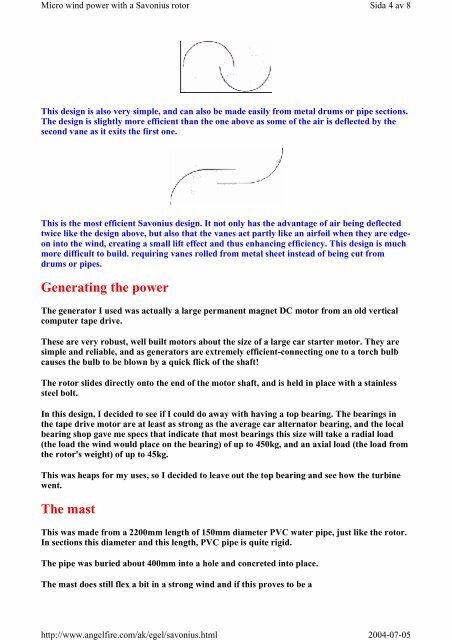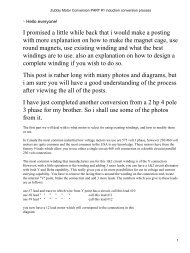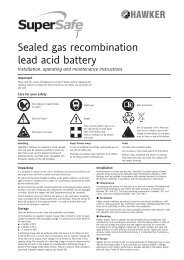Micro wind power with a Savonius rotor - Otherpower
Micro wind power with a Savonius rotor - Otherpower
Micro wind power with a Savonius rotor - Otherpower
Create successful ePaper yourself
Turn your PDF publications into a flip-book with our unique Google optimized e-Paper software.
<strong>Micro</strong> <strong>wind</strong> <strong>power</strong> <strong>with</strong> a <strong>Savonius</strong> <strong>rotor</strong><br />
http://www.angelfire.com/ak/egel/savonius.html<br />
Sida 4 av 8<br />
2004-07-05<br />
This design is also very simple, and can also be made easily from metal drums or pipe sections.<br />
The design is slightly more efficient than the one above as some of the air is deflected by the<br />
second vane as it exits the first one.<br />
This is the most efficient <strong>Savonius</strong> design. It not only has the advantage of air being deflected<br />
twice like the design above, but also that the vanes act partly like an airfoil when they are edgeon<br />
into the <strong>wind</strong>, creating a small lift effect and thus enhancing efficiency. This design is much<br />
more difficult to build. requiring vanes rolled from metal sheet instead of being cut from<br />
drums or pipes.<br />
Generating the <strong>power</strong><br />
The generator I used was actually a large permanent magnet DC motor from an old vertical<br />
computer tape drive.<br />
These are very robust, well built motors about the size of a large car starter motor. They are<br />
simple and reliable, and as generators are extremely efficient-connecting one to a torch bulb<br />
causes the bulb to be blown by a quick flick of the shaft!<br />
The <strong>rotor</strong> slides directly onto the end of the motor shaft, and is held in place <strong>with</strong> a stainless<br />
steel bolt.<br />
In this design, I decided to see if I could do away <strong>with</strong> having a top bearing. The bearings in<br />
the tape drive motor are at least as strong as the average car alternator bearing, and the local<br />
bearing shop gave me specs that indicate that most bearings this size will take a radial load<br />
(the load the <strong>wind</strong> would place on the bearing) of up to 450kg, and an axial load (the load from<br />
the <strong>rotor</strong>'s weight) of up to 45kg.<br />
This was heaps for my uses, so I decided to leave out the top bearing and see how the turbine<br />
went.<br />
The mast<br />
This was made from a 2200mm length of 150mm diameter PVC water pipe, just like the <strong>rotor</strong>.<br />
In sections this diameter and this length, PVC pipe is quite rigid.<br />
The pipe was buried about 400mm into a hole and concreted into place.<br />
The mast does still flex a bit in a strong <strong>wind</strong> and if this proves to be a





